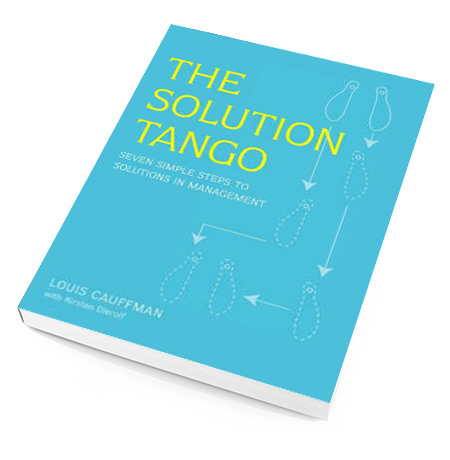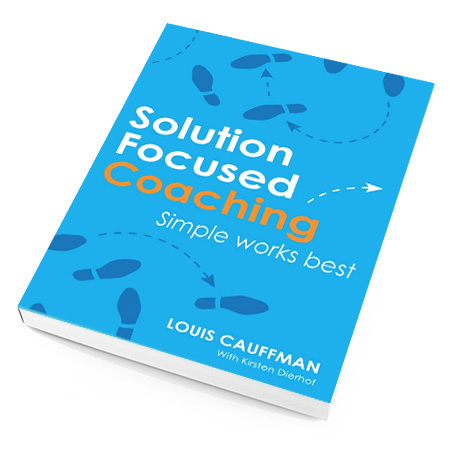Episode 9 – The Man in the Middle: A Solution Focused Feuilleton
Steve: “Shall we take this a little step forward, Peter?”
Peter: “Yes please.”
Steve: “In our first meeting you told me that you would like to see everybody work together again in the old style. You would like to see people less self-interested and focused on their own career. Instead, you would like to reinstall a team spirit so that work can become enjoyable again, like in your pioneering days. That certainly would make your team more effective. By the way, Peter, you know the acronym T.E.A.M?”
Peter: “I haven’t got a clue.”
Steve: “T.E.A.M. stands for Together Everybody Achieves More.”
Peter: “Wonderful! Can I quote you on that? It’s a good slogan. I will use it.”
Steve: “Sure, Peter, feel free to use it whenever you think it’s useful for Solteam.”

Steve doesn’t lecture Peter on what he should or shouldn’t do as a leader. Instead he uses this acronym, which then works as an eye-opener for Peter. This “economy of words” saves you lots of rational explaining and lots of effort in getting the message across. It simply works better. The right word in the right context can work miracles!
Steve continues: “So when this miracle happens, your project teams will be more focused on the good of the company instead of being preoccupied with their own career. What do you as the leader of your team need to do differently to accomplish this refocusing? How could you achieve this? After all, someone has to set an example.”
Peter: “Right. I do realize that I can’t change the others but that I can only change myself.”
Steve: “Exactly.”
Peter: “But how am I supposed to do that? John doesn’t trust me with the new project. By the way, he abolished the ‘milestone meetings’ that were essential for having an overall view on all running projects. I really don’t see how I can get all the new employees on the same wavelength without those meetings, let alone how I could re-install a minimal team spirit.”
We can see Peter moving on the flowchart towards the buyer position. Now his request for help is workable but he doesn’t know how to apply his resources. Peter did a good job at building effective teams in the past. That indicates that he has the resources to solve the problem but for the moment he doesn’t know how to access these resources. Peter doesn’t have a clue what to do. So now, Steve’s job is to help Peter tap into his resources. More solution-focused questions will do the job.
Steve: “Don’t worry, Peter. You will find a way. Maybe there are some possibilities that you just don’t see for the moment. Let’s take a little step back. How did you manage to do this in past projects? What method did you use in the past when you had to start up similar projects?”
Steve helps Peter to focus on what worked in the past. In other words, he helps Peter to discover solutions from the past that, if adjusted, are useful possible solutions for the future.
Peter: “Like I said, we used to have these big meetings in which all project teams in the department were involved. These ‘milestone meetings’ allowed us to have an overview of what was going on. But John is against that. He thinks it is unnecessary and too expensive. He insists on one-on-one communication, which I don’t think is the most effective thing to do.”
Steve: “What else, besides your ‘milestone meetings’, did you use in the past that was useful?”
Steve doesn’t go into Peter’s problem-oriented approach. Convinced that Peter will eventually generate solutions, Steve continues to ask him solution-building questions.
Peter: “We used to have a lot of informal contact. We talked about our projects in the corridors, at the coffee machine, wherever. We hung out together in the late afternoons. Plus, I often cut big projects into pieces.”
Steve: “I don’t really understand that — what do you mean?”
Peter: “Well, I designed an overall project plan that overarched all projects that my department was doing simultaneously. Even though in reality this master plan was never executed the way it was designed, it was the general guideline for everyone. Then I used to cut every single large project into small, quasi-independent projects and got the different teams going at their piece. It looked pretty chaotic at times, but we learned to let go of the strict project planning. Allowing unpredictability was tough, and I am sure you can understand that, being an engineer yourself. As the projects moved slowly down the tracks, the pieces of the puzzle would eventually fall together. This sounds rather complicated, I know, but it worked in the past.”
Steve: “Wonderful. What stops you from doing that now?”
Peter: “I don’t know, with all the new employees who don’t really know Solteam. that well, it could be very difficult. And John would never go for it — he wants to survey everything and keep it under control himself.”
Peter just described several resources and tools that he used success- fully in the past. However, he doesn’t know how to use them at the moment. He is now clearly in the buyer position. Peter needs help to enable him to use his own resources again. He needs advice. Because advice and suggestions followed by a question mark work better then telling people what to do, Steve will simply ask suggestive questions.
Steve: “OK, but that doesn’t have to be a problem. Couldn’t you hold small, informal meetings again like when you celebrated your employee’s birthday? Show up at the coffee machine more frequently, stuff like that? During those occasions you could talk about the dismantling project. I am sure that there are enough employees, including some of the new employees, who would very much like to participate in these chats. Furthermore, without telling anyone, you could design a master plan for the dismantling project and cut it down into small pieces. You have done it before, so you know how to do it, and it sure was successful! You could do this in a few days, couldn’t you? When you are ready with it, you casually mention your plan during a coffee break or lunch, and you just wait and see how your teammates react to it. What do you think, Peter, is this feasible?”
On the surface, it seems like Steve is asking questions which Peter can answer freely. But in fact, Steve is suggesting to Peter how to behave. There is little chance that Peter will resist these prescriptions, for the simple reason that he himself proposed them. This is a fine example of co-creating solutions and building on them by asking solution-focused questions.
(to be continued)
Read episode 10
Back to episode overview
‘The Man in the middle’ is an excerpt from the book ‘The Solution Tango’ (and ‘Solution Focused Coaching’ e-book) by Louis Cauffman. This book presents a new approach to conquering the numerous challenges, problems, and failures that managers encounter at work, many of which are people-related. An important lesson identified in the book is that a manager must act as both the leader who provides direction for a team or company and as the coach who enables others to make the most of their skills, enabling the individual and the organization to succeed. A seven-step framework to enhance problem-solving capabilities, examples and tips, and a survival kit for sinking managers will help managers improve their people skills and learn how to approach everyday issues from a positive perspective.
 LOUISCAUFFMAN.COM
LOUISCAUFFMAN.COM
